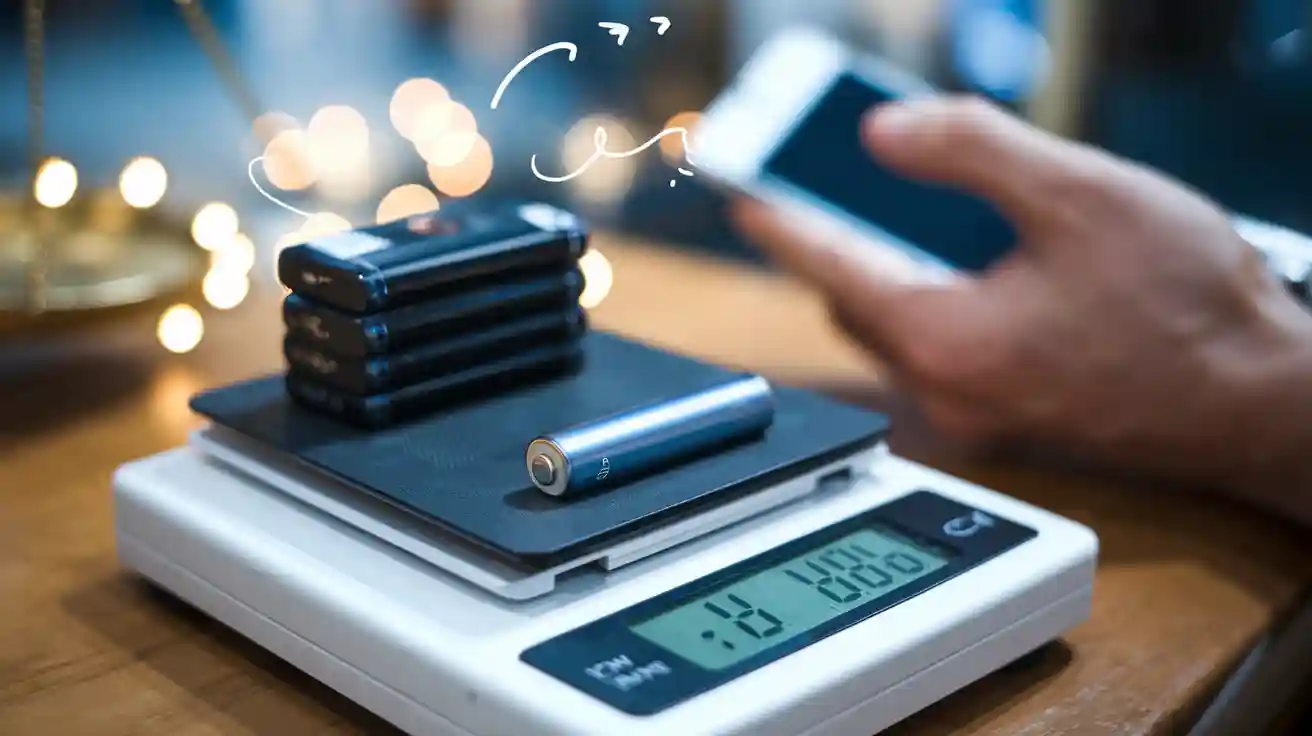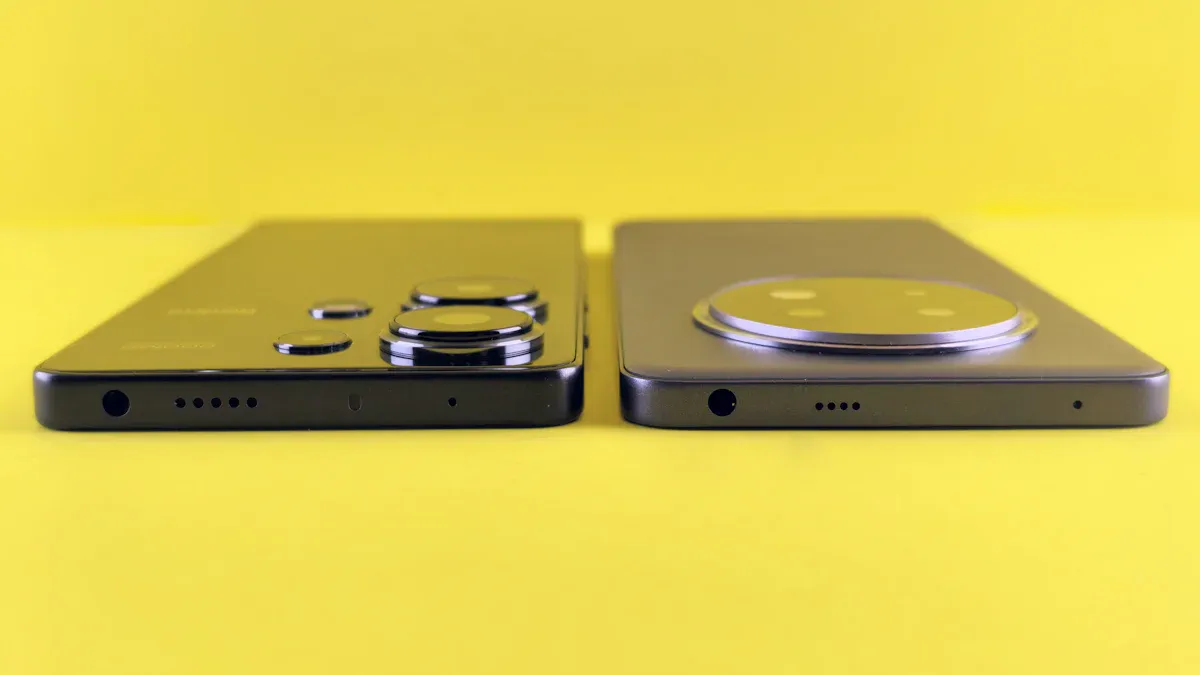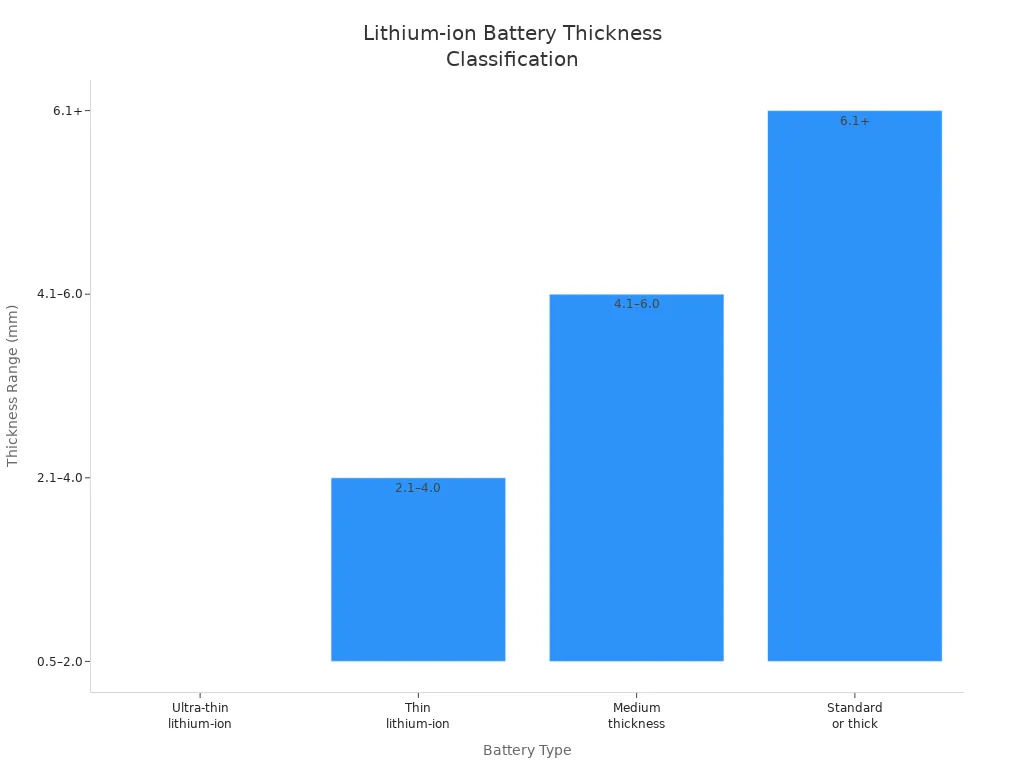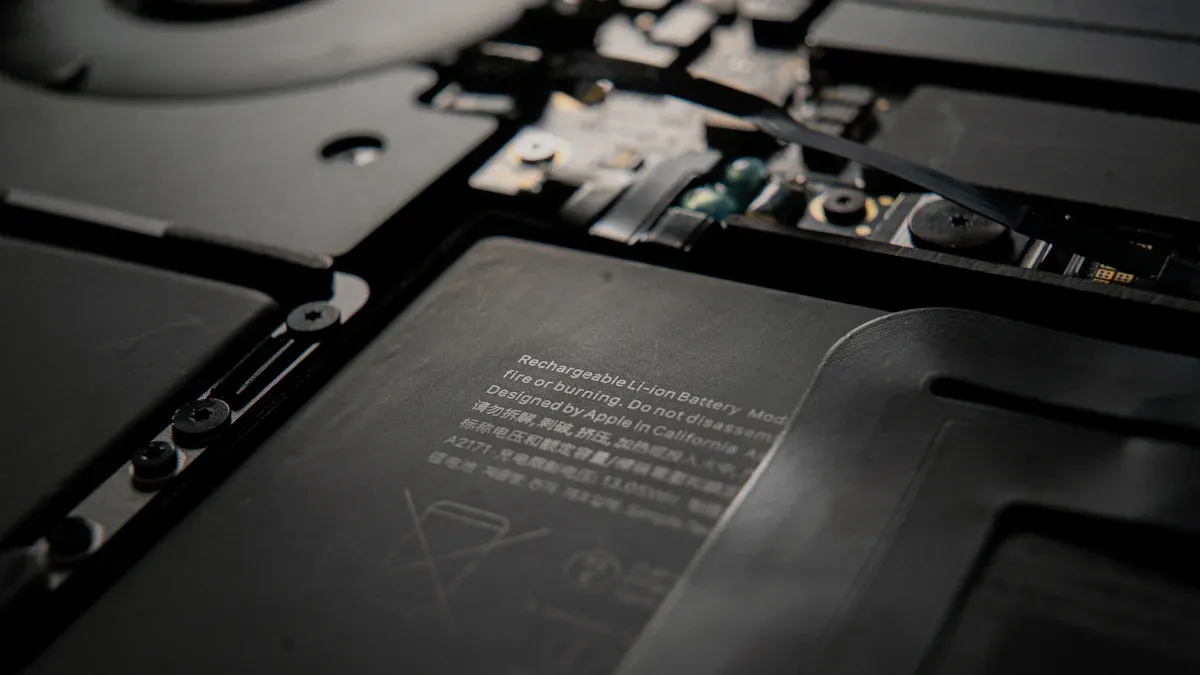
You notice that thin lithium ion battery design makes slim and lightweight devices possible by using less material. Thin lithium polymer batteries use ultrathin separators with special metal-organic frameworks to cut down weight and boost energy density. These separators also improve safety by stopping dangerous dendrite growth. Thin lithium ion battery electrodes need to stay thin for good performance and safety, because thick electrodes can cause problems like poor performance and shorter life. Thin lithium polymer batteries let you enjoy flexible lithium-ion battery options, strong performance, and better safety. Thin lithium polymer batteries help with integration in compact designs, so you get more power, safety, and performance in less space. Thin lithium polymer batteries keep safety high while supporting top performance for everyday devices.
Thin Lithium Ion Battery Basics

Thickness and Weight
When you look at thin lithium ion battery technology, you see that reducing thickness directly lowers weight. A thinner battery uses less material, which means your device feels lighter in your hand or pocket. This change makes a big difference in how portable your electronics become.
You can compare different battery types by their thickness. The table below shows how thin lithium ion battery designs stack up against standard batteries:
| Thickness Range (mm) | Classification |
|---|---|
| 0.5 – 2.0 | Ultra-thin lithium-ion batteries |
| 2.1 – 4.0 | Thin lithium-ion batteries |
| 4.1 – 6.0 | Medium thickness batteries |
| 6.1 and above | Standard or thick lithium-ion batteries |

Thin lithium ion battery designs usually measure between 2.1 mm and 4.0 mm. Standard batteries start at 6.1 mm or more. This difference means you get a much lighter battery for the same or even better performance. When you choose thin lithium polymer batteries, you help your device achieve a higher energy-to-weight ratio. This means your device can store more energy without adding extra weight. You also benefit from a space-saving design, which lets manufacturers create slimmer phones, tablets, and wearables.
Separator and Electrode Design
You find that separators and electrodes play a huge role in both the weight and performance of thin lithium ion battery cells. Manufacturers use special materials to keep batteries light and safe.
- Polyethylene (PE) and polypropylene (PP) are the main polymers for separators. These materials offer chemical stability and strong mechanical properties.
- Shutdown separators use layers of PE and PP to stop ion flow if the battery gets too hot, which keeps you safe.
- Some separators have a ceramic coating for extra safety, but this adds weight and cost.
- Lithium metal serves as an anode in some thin lithium polymer batteries. It has a high energy-to-weight ratio and low density, so it helps reduce overall battery weight.
- Cathodes often use lithium cobalt oxide or sulfur. Sulfur is popular in some designs because it offers high energy density and low cost.
Tip: Lightweight polymer separators help keep thin lithium polymer batteries light, while ceramic coatings add safety but increase weight.
Separator thickness usually ranges from 12 to 25.4 micrometers. Thinner separators allow for more active material, which boosts high energy density. You also see new trends in separator technology. Nano-coated ceramic or polymer separators improve thermal stability and ion conductivity. Flexible and porous separators make thin lithium polymer batteries perfect for wearables and flexible electronics. Some separators even have embedded sensors to monitor battery health in real time.
Electrodes also matter. When you use smaller and more uniform particles in the electrode, you increase the surface area. This change speeds up lithium-ion movement and improves conductivity. Smaller particles shorten the path for ions, which means faster charging and better performance. Thin-film construction, especially with multilayer designs, helps solve problems with silicon anodes. For example, adding a silver layer between silicon films relieves stress and boosts conductivity. This approach increases capacity retention and cycling stability, so your thin lithium polymer batteries last longer and perform better.
You benefit from these innovations because thin lithium ion battery designs deliver a high energy-to-weight ratio and high energy density. These features make your devices lighter, slimmer, and more powerful.
Performance Benefits
Energy Density
You want your devices to last longer without getting heavier. Thin lithium-ion batteries help you reach this goal by focusing on high energy density. This means you get more power stored in a smaller and lighter battery. High energy density lets your phone, tablet, or wearable run for hours while staying slim and light.
Recent research shows that thin lithium-ion batteries with LLZO solid electrolytes can reach about 272 Wh/kg. This number is only a little higher than the 250-270 Wh/kg range found in most conventional lithium-ion batteries. You might expect a big jump in high energy density, but the difference is small. The volumetric energy density can reach around 823 Wh/L, but the extra weight and brittleness of LLZO materials can reduce the real benefits you see in daily use.
Note: Scientists are working on hybrid electrolyte designs, like LLZO-in-polymer composites, to make thin batteries more flexible and easier to produce. These new ideas could help boost high energy density and make batteries safer for your devices.
You see that high energy density is not just about numbers. It means you can carry your device all day without worrying about the battery running out. Thin lithium-ion batteries give you this advantage while keeping your gadgets light and easy to use. High energy density also helps with fast charging, so you spend less time waiting and more time using your device.
Power and Conductivity
You care about how quickly your device charges and how well it performs. Thin lithium-ion batteries improve performance by using advanced materials and smart designs. When you use smaller particles in the electrodes, you get better conductivity. This means ions move faster inside the battery, which leads to fast charging and strong performance.
Manufacturers use thin-film construction to make sure the battery stays light but still delivers high energy density. This design helps your device handle fast charging without overheating or losing performance. You notice that thin lithium-ion batteries can charge up quickly and deliver power when you need it most.
Here are some ways thin lithium-ion batteries boost performance:
- Thin electrodes shorten the path for ions, so you get fast charging and better performance.
- Special separators keep the battery safe and support high energy density.
- Flexible designs allow for better integration in slim devices, which improves performance and user experience.
- High conductivity materials help maintain performance even after many charge cycles.
| Merkmal | Benefit for You |
|---|---|
| Thin electrodes | Faster ion movement, fast charging, better performance |
| High energy density | Longer battery life, lighter devices |
| Advanced separators | Improved safety, stable performance |
| Flexible construction | Slimmer, more portable devices |
You see that fast charging is now a key feature in many devices. Thin lithium-ion batteries make this possible by supporting high energy density and strong performance. You can charge your phone or tablet in minutes instead of hours. This change makes your life easier and keeps you connected.
Tip: If you want the best performance and fast charging, look for devices that use thin lithium-ion batteries with high energy density. These batteries give you the power you need without adding extra weight.
Thin lithium-ion batteries set a new standard for performance in modern electronics. You get high energy density, fast charging, and reliable performance in a slim package. This combination helps you enjoy your devices without compromise.
Thin Lithium Polymer Batteries
Structure and Flexibility
You see that thin lithium polymer batteries stand out because of their unique structure. These batteries use a gel-like or solid polymer electrolyte instead of a liquid one. The separator in thin lithium polymer batteries holds the electrolyte and can stop current flow if the battery overheats. This design keeps your devices safer.
- Thin lithium polymer batteries use a flexible aluminum foil pouch instead of a hard metal case. This pouch makes the battery lighter and lets it bend or fit into tight spaces.
- You can find thin lithium polymer batteries in many shapes and sizes. Some are less than 1 mm thick, which helps make ultra-slim devices.
- The flexible construction allows these batteries to fit into curved or custom-shaped spaces. You see this in smartwatches, fitness bands, and even medical patches.
- Thin lithium polymer batteries have fewer parts than traditional lithium-ion batteries. This makes them easier to shape and lighter to carry.
The flexible lithium-ion battery design lets you enjoy lighter devices that feel comfortable and easy to use. You benefit from batteries that can fit into almost any device, no matter the shape.
Mechanical Performance
Thin lithium polymer batteries offer strong mechanical performance. You want a battery that is not only light but also tough and safe. These batteries use a solid or semi-solid polymer matrix, which gives them better mechanical stability than traditional batteries.
| Mechanical Metric | Value / Description | Benefit for You |
|---|---|---|
| Tensile Modulus | 3.1 GPa | High stability, less risk of damage |
| Young’s Modulus | 0.5 GPa | Good flexibility, resists bending |
| Mechanical Strength | 213 MPa | Withstands pressure, stays safe |
| Flexibility | Can bend up to ~90° | Fits curved or tight spaces |
| Dicke | As thin as 0.5 mm | Enables slim, portable devices |
| Sicherheit | Reduced risk of leakage and puncture | Safer for daily use |
Thin lithium polymer batteries can bend up to about 90 degrees without breaking. The flexible construction means you can use them in devices that need to move or flex, like wearables and flexible screens. You also get better safety because these batteries do not leak like traditional ones. The flexible lithium-ion battery design supports new ideas in electronics, making your devices lighter, safer, and more reliable.
Applications of Thin Lithium-Ion Batteries

Unterhaltungselektronik
You see the applications of thin lithium-ion batteries everywhere in your daily life. These batteries power many of your favorite devices. Manufacturers use them to make gadgets lighter, slimmer, and more comfortable to carry.
- You find thin lithium-ion batteries in smartphones and tablets. These batteries help make your devices thinner and lighter, so you can hold them for hours without feeling tired.
- Ultrabook laptops use these batteries to stay light and easy to carry in your backpack.
- Wearables like smartwatches and fitness trackers rely on thin lithium-ion batteries. The batteries keep these devices small and comfortable on your wrist.
- Augmented reality glasses use thin batteries to stay lightweight and easy to wear for long periods.
Thin lithium-ion batteries, especially lithium polymer types, let companies design devices in new shapes and sizes. You get smartphones and tablets that are not only slim but also powerful enough for gaming and streaming. Wearables last longer on a single charge, so you can track your health all day. Even drones and electric vehicles benefit from these batteries, as they need lightweight power sources to fly or drive longer distances.
Tip: Always use certified batteries in your devices. Certified batteries lower the risk of overheating or damage, especially as batteries become thinner and more powerful.
Medizinische Geräte
You also see the applications of thin lithium-ion batteries in the medical field. These batteries help make medical devices smaller, lighter, and easier to use. Doctors and patients both benefit from these improvements.
- Portable medical monitors use thin lithium-ion batteries to become more compact and comfortable for patients.
- Wearable health devices, like heart rate monitors and smart patches, rely on these batteries for long-lasting power without adding weight.
- Implantable devices, such as pacemakers, use thin batteries to reduce discomfort and make surgery less invasive.
Thin lithium-ion batteries have a high energy-to-weight ratio. This means medical devices can stay light without losing power. You get devices that are easier to carry and use, whether you are a patient or a healthcare worker. The slim profile of these batteries lets manufacturers create sleek, discreet devices that improve patient comfort and mobility. Drones and electric vehicles used in hospitals for delivery or transport also use these batteries to stay light and efficient.
The applications of thin lithium-ion batteries continue to grow as technology advances. You will see even more uses in both consumer electronics and medical devices in the future.
Applications of Flexible Lithium-Ion Batteries
Wearables
You see flexible lithium-ion batteries changing the way you use tragbare Geräte. These batteries bend, fold, and stretch, so your smartwatches, fitness bands, and health patches stay comfortable and safe. You can wear these gadgets all day because the batteries are thin, lightweight, and stretchable. This design improves comfort and lets you move freely.
- Flexible lithium-ion batteries resist impact and damage, so your devices last longer.
- They use ductile materials in electrodes and electrolytes, which helps them bend without breaking.
- Solid-state or gel polymer electrolytes prevent leaks and stop dangerous dendrites from forming.
- Many batteries are waterproof and flame-retardant, so you stay safe even during intense activities.
- Some batteries even have self-healing abilities, which means they can recover from small cuts or damage.
Note: Flexible lithium-ion batteries keep working even when you twist or bend your wearable device. This stability is important for health trackers and smart clothing.
You benefit from these features because your wearable devices can fit better, last longer, and keep you safe. The applications of flexible lithium-ion batteries in wearables continue to grow as new designs appear.
Emerging Technologies
You find the applications of flexible lithium-ion batteries expanding into new and exciting areas. Researchers have created batteries that power devices like smart contact lenses, health-monitoring stickers, and flexible displays. These batteries can bend, stretch, and twist without losing power, which opens up many new possibilities.
- Smart contact lenses use mini flexible batteries to track health or display information.
- Wearable RFID stickers help monitor your health and send data wirelessly.
- Flexible batteries power biomedical sensors that stick to your skin and track your health in real time.
- E-textiles and smart clothing use these batteries for built-in heating or health monitoring.
- Flexible displays and foldable phones rely on these batteries for power and design freedom.
You see companies like LG Chem, Samsung SDI, and Apple working on new flexible battery designs. These batteries use carbon-based materials like graphene and carbon nanotubes to stay strong and flexible. Advanced techniques, such as 3D printing, help make batteries that fit any shape or size.
Tip: The applications of flexible lithium-ion batteries help create devices that are lighter, safer, and more adaptable. You will see more wearable tech, smart textiles, and flexible electronics in the future.
Trade-Offs and Considerations
Capacity Limits
When you choose thin lithium-ion batteries, you often notice a trade-off between size and how long your device runs. Thin batteries have lower capacity limits than standard batteries. This means they store less energy and deliver less current. You might see your device shut down sooner, especially if you use it for heavy tasks. Thin batteries also have higher internal resistance, which makes it harder for them to deliver power quickly. If you use a device with a thin battery, you may notice it stops working even when some energy remains. This happens because the voltage drops early to protect the battery and keep safety high.
Note: Devices with thin lithium-ion batteries often cut off at about 3V per cell. This protects the battery but means you cannot use all the stored energy.
Manufacturers work hard to balance weight, performance, and safety. They use advanced materials and smart designs, but thin batteries still provide shorter runtimes than thicker ones. You get a lighter device, but you may need to charge it more often.
Durability and Safety
You want your battery to last and keep you safe. Thin lithium-ion batteries can last a long time, especially in medical devices. Some thin-film batteries reach up to 50,000 cycles in special uses. Most thin batteries use solid electrolytes, which improve safety and durability. You benefit from a battery that resists leaks and damage.
| Merkmal | Thin-Film Lithium-Ion Battery | Conventional Lithium-Ion Battery |
|---|---|---|
| Zyklus Leben | Up to 50,000 cycles | Over 1,000 cycles |
| Electrolyte Type | Solid (safer, more durable) | Liquid (risk of leaks) |
| Safety Devices | Multiple built-in protections | Standard protections |
Safety is a top concern with thin lithium-ion batteries. Ultra-thin separators can let tiny metal particles cause short circuits. This can lead to thermal runaway and fires. Manufacturers add many safety features, such as vents, fuses, and electronic circuits that watch voltage and temperature. They also keep factories very clean and test millions of batteries before using them in important devices. You see extra safety steps like using safer cathode materials and adding dividers between cells. These steps help stop problems from spreading.
Tip: Always handle batteries with care and use only approved chargers. This helps keep safety high and prevents accidents.
Manufacturers also use cooling systems and special coatings to improve safety. They test batteries for safety under stress, like nail penetration or overheating. Even with all these steps, safety depends on careful design and clean manufacturing. You can trust thin lithium-ion batteries in your devices because companies focus on safety at every step.
You see thin lithium-ion battery design making your devices lighter and slimmer. These batteries use advanced materials and smart structures to reduce weight and improve safety. You benefit from high energy density, fast charging, and flexible shapes. Thin batteries fit into small devices, helping with miniaturization and safety. You notice that safety stays high, even as batteries get thinner. Manufacturers focus on safety by using solid-state electrolytes and new coatings. Safety features protect you from leaks, fires, and damage. The table below shows how new battery innovations improve safety and performance:
| Innovation Aspect | Beschreibung |
|---|---|
| Akku-Typ | Flexible batteries using thin-film technology |
| Key Materials | Lithium-polymer, zinc-based, printed organic layers |
| Flexibility Features | Bend and twist without losing electrical properties |
| Electrolyte Types | Solid-state or advanced liquid electrolytes for better safety |
| Benefits | Enable thin, light, and safe designs for wearables and medical devices |
| Safety and Durability | Solid-state electrolytes offer improved safety and non-flammability |
You can expect more progress in safety and battery technology. Thin lithium-ion batteries will keep shaping the future of portable electronics by making devices safer, lighter, and more powerful.
FAQ
What makes thin lithium-ion batteries lighter than regular batteries?
You get a lighter battery because thin lithium-ion batteries use less material. Manufacturers reduce the thickness of separators and electrodes. This design helps your device feel lighter and easier to carry.
Can thin lithium-ion batteries charge faster?
Yes, you can charge thin lithium-ion batteries faster. Thin electrodes allow ions to move quickly. This feature supports fast charging and helps your device stay ready when you need it.
Are thin lithium-ion batteries safe to use?
You stay safe with thin lithium-ion batteries. These batteries use advanced separators and solid electrolytes. Manufacturers add safety features like vents and fuses to prevent overheating or short circuits.
Where do you find thin lithium-ion batteries in daily life?
You find thin lithium-ion batteries in smartphones, tablets, wearables, and medical devices. These batteries help make your gadgets slim, light, and easy to use every day.
Do thin lithium-ion batteries last as long as thicker ones?
Thin lithium-ion batteries may have shorter runtimes than thicker batteries. You might need to charge your device more often. However, you still get strong performance and safety for most daily uses.

